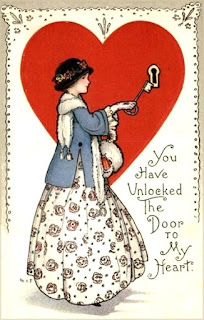As is often true, the ultimate origin of Valentine's Day is unknown, though there are plenty of juicy legends repeated as fact, all disputed by at least some scholars. But the one makes the most sense to me is this: its roots are in the ancient Roman festival of Lupercalia, held on the Ides of February (February 15.)
Lupercalia was an early spring fertility festival, ostensibly in honor of a god of agriculture but also of Rome's founders, Romulus and Remus. According to that origin legend, they were twin boys abandoned in a cave and raised by a wolf (Latin and Harry Potter scholars will recognize that "lupa" in Lupercalia means a she-wolf.) The festival traditionally began with a rite at that legendary cave.
But the rest of Lupercalia was dedicated to different sorts of fertility, with naked drunks running through the streets (some suggest the day also honored the god Pan), past married women who hoped they would become pregnant or have an easy delivery if they were touched by the goat's hide strips the men brandished.Yet another custom--more related to today's holiday-- was a lottery in which unmarried women dropped their names into an urn for unmarried men to randomly extract. The two would become a couple, presumably including sexual favors, either for the course of the festival or (according to other sources) the entire year. This even speedier variation on speed dating often (it is said) resulted in marriage.
All of this went on for centuries, until the Catholic Church finally predominated. In the fifth century, the Pope banned Lupercalia, and replaced it with St. Valentine's Day. Some sources claim that the choice of St. Valentine was simply because he was officially martyred on that date. Maybe. But whenever the Church replaced a pagan feast day, or built a church over a pre-Christian sacred site, the replacement is often related to the earlier intent-- especially since Indigenous and other pre-Christian special days were related to natural cycles of the calendar, such as when birds and other animals begin mating in the early spring.
Besides, there are stories of at least three St. Valentines, all supposedly martyred, and none proven to have existed. But by the Middle Ages the Church had a great cover story to relate Valentine to the Lupercalia, without saying so. According to this legend, it all started when the third century Roman emperor Claudius II banned marriage.Claudius had risen through the military (the first Emperor to have done so, and the first to be of "barbarian" birth) and thought marriage made soldiers weak and fretful, distracted by wives and children at home. And Claudius was often at war.
But a Christian prelate in Rome called Valentine continued to secretly marry couples, until he came to the attention of Claudius. During Valentine's imprisonment, he and Claudius had lively discussions, each trying to convert the other to their religion. But only one of them was the emperor, so Valentine was executed.
Did any of this happen? Outlawing marriage was not entirely unknown in Rome, but the encyclopedia entry that Wikipedia uses doesn't mention Claudius II (also known as Claudius Gothicus) doing so. There is a further addition to the legend that says while he was imprisoned, Valentine had some sort of relationship--perhaps even fell in love with--his jailer's daughter. Before his execution, he left her a note, "from your Valentine." Right--at least a degree of cuteness too far.
But by the Middle Ages, Valentine was a popular saint across Europe, and St. Valentine's Day became a day for celebrating early love, a sanitized--or at least euphemistic-- version of the Roman holiday. The tradition of the card now called the valentine may have also derived from the age-old traditions of Lupercalia. Denied their lottery, it's said that young Roman men sent handwritten greetings to women they admired on the mid-February date.But the first documented (and still existing) valentine card was sent by Charles, duke of Orleans in 1415. He sent it to his wife, who happened to be a prisoner in the Tower of London at the time.
Handmade cards began to bear the image of Cupid (also related to Roman love customs) and to include amorous verses. The printing press made the "mechanical valentine" a thing, and lower postal rates in 19th century England meant they didn't need to be hand-delivered, and could even be sent anonymously. This led to more explicit imagery and racy verses, to the extent that in 19th century Chicago, some 25,000 valentines were deemed too obscene to deliver.
Among the rude cards of the 19th and early 20th centuries were "vinegar valentines," that expressed insults--doubly so, since it often was the receiver and not the sender who had to pay the postage. Meanwhile, erotic valentines--intended as humorous or maybe not--survive into the 21st century.As for the Xs denoting kisses on valentines and other written notes--which likely makes it the first emoji--they seem to be a remnant from illiterate times when many could sign their name only with an X, and sealed it with a kiss. If present trends continue, those days may not be gone forever.





